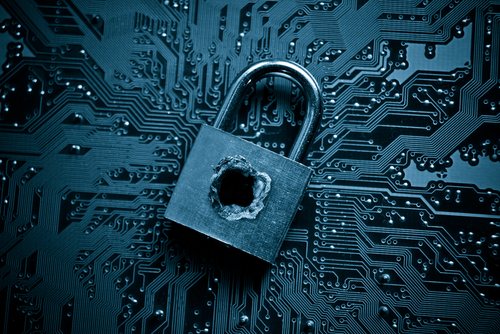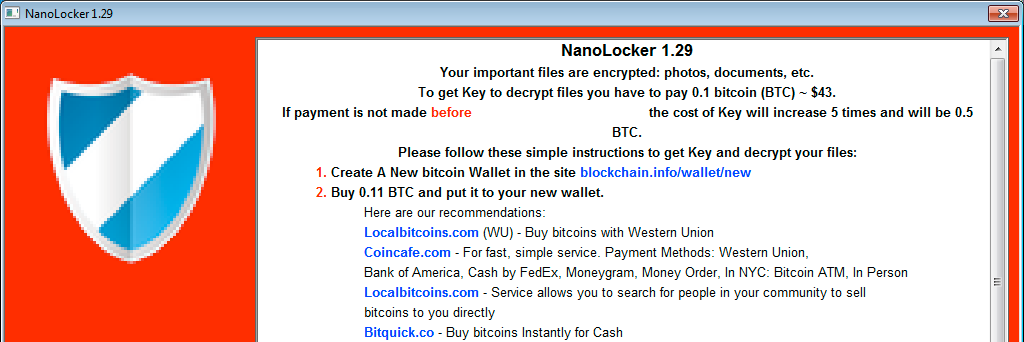 A new ransomware has recently appeared, going by the name of NanoLocker Ransomware. The malicious infection may encrypt the important user files on the hard drive as well as portable drives attached to the victim computer with a new extension. Such files become corrupt, and the only way to decrypt them is via a decryption key. The ransomware may also leave a ransom note with ransom instructions, demanding money from the victims. All users affected by NanoLocker Ransomware are strongly advised not to pay any ransom money that may be requested from them and to look for alternative methods for decryption and removal, instructions for which we have provided after this article.
A new ransomware has recently appeared, going by the name of NanoLocker Ransomware. The malicious infection may encrypt the important user files on the hard drive as well as portable drives attached to the victim computer with a new extension. Such files become corrupt, and the only way to decrypt them is via a decryption key. The ransomware may also leave a ransom note with ransom instructions, demanding money from the victims. All users affected by NanoLocker Ransomware are strongly advised not to pay any ransom money that may be requested from them and to look for alternative methods for decryption and removal, instructions for which we have provided after this article.
| Name | NanoLocker Ransomware | |
| Type | Ransomware | |
| Short Description | The malicious threat ecrypts user files and demands ransom money for their decryption. | |
| Symptoms | The user may witness a ransom massage and his/her files encrypted with an unfamiliar file extension. The files cannot be opened by removing the extension. | |
| Distribution Method | Via malicious links posted online or malicious email attachments | |
| Detection Tool | Download Malware Removal Tool, to See If Your System Has Been Affected by malware | |
| User Experience | Join our forum to follow the discussion about NanoLocker Ransomware. | |
| Data Recovery Tool | Windows Data Recovery by Stellar Phoenix Notice! This product scans your drive sectors to recover lost files and it may not recover 100% of the encrypted files, but only few of them, depending on the situation and whether or not you have reformatted your drive. |
NanoLocker Ransomware – How Did I Get Infected with It
This ransomware may be distributed in more than just malicious web links posted in spam comments online. Such links or attachment files may be included in spam e-mails as well. One of such mails may contain the following types of malicious attachments or archives:
→ Files: .docx; .bat; .vbs; .exe; .pdf;
Archives: .zip; .rar
Furthermore, the ransomware may be distributed via malicious files shared in torrent websites that are not reputable. Such files may be a malicious payload carrier, resembling a keygen, crackfix or a patch for a video game or other software.
NanoLocker Ransomware – What Does It Do
According to Symantec Security Response, once its malicious files have affected the user PC, the ransomware may displays a fake PDF error message and begins to drop its module files:
- %UserProfile%\Desktop\ATTENTION.RTF
- %UserProfile%\Desktop\Decryptor.lnk
- %UserProfile%\Application Data\lansrv.exe
- %UserProfile%\Application Data\lansrv.ini
These files are also known as modules or payload of the ransomware. The Ransomware infection then creates this registry entry for one of the modules:
→HKEY_CURRENT_USER\Software\Microsoft\Windows\CurrentVersion\Run\”LanmanServer” = “%UserProfile%\Application Data\lansrv.exe”
After these processes are done, the NanoLocker ransomware may run a module which begins to scan your computer for files of the most commonly used extensions and encrypt them:
→ 3g2 3gp aaf accdb aep aepx aet ai aif arw as as3 asf asp asx avi bay bmp cdr cer class cpp cr2 crt crw cs csv db dbf dcr der dng doc docb docm docx dot dotm dotx dwg dxf dxg efx eps erf fla flv idml iff indb indd indl indt inx jar java jpeg jpg kdc m3u m3u8 m4u max mdb mdf mef mid mov mp3 mp4 mpa mpeg mpg mrw msg nef nrw odb odc odm odp ods odt orf p12 p7b p7c pdb pdf pef pem pfx php plb pmd pot potm potx ppam ppj pps ppsm ppsx ppt pptm pptx prel prproj ps psd pst ptx r3d ra raf rar raw rb rtf rw2 rwl sdf sldm sldx sql sr2 srf srw svg swf tif vcf vob wav wb2 wma wmv wpd wps x3f xla xlam xlk xll xlm xls xlsb xlsm xlsx xlt xltm xltx xlw xml xqx zip
After the encryption is successful, the user may see his files to become corrupt when he/she tries to open them. They may also have unfamiliar file extension and the user`s wallpaper may be changed, along with files dropped on his desktop that may contain the following message with instructions on how to bring back his/her files:
Furthermore, the ransomware may also have the ability to delete Volume Shadow Copies and backups so that there is no way of decrypting the data. What is more is that the NanoLocker ransomware may open ports to connect to remote hosts, one of which is 52.91.55.122. This is believed to be the Command and Control (C&C) center ran by the cyber-criminals.
Removing NanoLocker Ransomware
This ransomware infection`s behavior is almost identical to any other Trojan horse. This means that to remove it you must isolate the threat first. This is why it is strongly advisable to disconnect from the web and copy the encrypted files to a portable drive just in case. Then you should download an advanced anti-malware scanner from a safe computer and install it on the infected one. After this you may follow the following instructions to safely scan your device below:
Restoring Your Encrypted Files
To attempt getting back your files it is recommended to start recovering them with the following methods:
To restore your data, your best bet is to check again for shadow volume copies using this software:
The other method of restoring your files is by trying to bring back your files via data recovery software. Here are some examples of data recovery programs:
- Stellar Phoenix Data Recovery Technicians License(Pro version with more features)
- Stellar Phoenix Windows Data Recovery
- Stellar Phoenix Photo Recovery
You may also try decrypting different files using Kaspersky`s decryptors:
Kaspersky Decryption Utilities
- Step 1
- Step 2
- Step 3
- Step 4
- Step 5
Step 1: Scan for NanoLocker Ransomware with SpyHunter Anti-Malware Tool



Ransomware Automatic Removal - Video Guide
Step 2: Uninstall NanoLocker Ransomware and related malware from Windows
Here is a method in few easy steps that should be able to uninstall most programs. No matter if you are using Windows 10, 8, 7, Vista or XP, those steps will get the job done. Dragging the program or its folder to the recycle bin can be a very bad decision. If you do that, bits and pieces of the program are left behind, and that can lead to unstable work of your PC, errors with the file type associations and other unpleasant activities. The proper way to get a program off your computer is to Uninstall it. To do that:


 Follow the instructions above and you will successfully delete most unwanted and malicious programs.
Follow the instructions above and you will successfully delete most unwanted and malicious programs.
Step 3: Clean any registries, created by NanoLocker Ransomware on your computer.
The usually targeted registries of Windows machines are the following:
- HKEY_LOCAL_MACHINE\Software\Microsoft\Windows\CurrentVersion\Run
- HKEY_CURRENT_USER\Software\Microsoft\Windows\CurrentVersion\Run
- HKEY_LOCAL_MACHINE\Software\Microsoft\Windows\CurrentVersion\RunOnce
- HKEY_CURRENT_USER\Software\Microsoft\Windows\CurrentVersion\RunOnce
You can access them by opening the Windows registry editor and deleting any values, created by NanoLocker Ransomware there. This can happen by following the steps underneath:


 Tip: To find a virus-created value, you can right-click on it and click "Modify" to see which file it is set to run. If this is the virus file location, remove the value.
Tip: To find a virus-created value, you can right-click on it and click "Modify" to see which file it is set to run. If this is the virus file location, remove the value.
Before starting "Step 4", please boot back into Normal mode, in case you are currently in Safe Mode.
This will enable you to install and use SpyHunter 5 successfully.
Step 4: Boot Your PC In Safe Mode to isolate and remove NanoLocker Ransomware





Step 5: Try to Restore Files Encrypted by NanoLocker Ransomware.
Method 1: Use STOP Decrypter by Emsisoft.
Not all variants of this ransomware can be decrypted for free, but we have added the decryptor used by researchers that is often updated with the variants which become eventually decrypted. You can try and decrypt your files using the instructions below, but if they do not work, then unfortunately your variant of the ransomware virus is not decryptable.
Follow the instructions below to use the Emsisoft decrypter and decrypt your files for free. You can download the Emsisoft decryption tool linked here and then follow the steps provided below:
1 Right-click on the decrypter and click on Run as Administrator as shown below:

2. Agree with the license terms:

3. Click on "Add Folder" and then add the folders where you want files decrypted as shown underneath:

4. Click on "Decrypt" and wait for your files to be decoded.

Note: Credit for the decryptor goes to Emsisoft researchers who have made the breakthrough with this virus.
Method 2: Use data recovery software
Ransomware infections and NanoLocker Ransomware aim to encrypt your files using an encryption algorithm which may be very difficult to decrypt. This is why we have suggested a data recovery method that may help you go around direct decryption and try to restore your files. Bear in mind that this method may not be 100% effective but may also help you a little or a lot in different situations.
Simply click on the link and on the website menus on the top, choose Data Recovery - Data Recovery Wizard for Windows or Mac (depending on your OS), and then download and run the tool.
NanoLocker Ransomware-FAQ
What is NanoLocker Ransomware Ransomware?
NanoLocker Ransomware is a ransomware infection - the malicious software that enters your computer silently and blocks either access to the computer itself or encrypt your files.
Many ransomware viruses use sophisticated encryption algorithms to make your files inaccessible. The goal of ransomware infections is to demand that you pay a ransom payment to get access to your files back.
What Does NanoLocker Ransomware Ransomware Do?
Ransomware in general is a malicious software that is designed to block access to your computer or files until a ransom is paid.
Ransomware viruses can also damage your system, corrupt data and delete files, resulting in the permanent loss of important files.
How Does NanoLocker Ransomware Infect?
Via several ways.NanoLocker Ransomware Ransomware infects computers by being sent via phishing emails, containing virus attachment. This attachment is usually masked as an important document, like an invoice, bank document or even a plane ticket and it looks very convincing to users.
Another way you may become a victim of NanoLocker Ransomware is if you download a fake installer, crack or patch from a low reputation website or if you click on a virus link. Many users report getting a ransomware infection by downloading torrents.
How to Open .NanoLocker Ransomware files?
You can't without a decryptor. At this point, the .NanoLocker Ransomware files are encrypted. You can only open them once they are decrypted using a specific decryption key for the particular algorithm.
What to Do If a Decryptor Does Not Work?
Do not panic, and backup the files. If a decryptor did not decrypt your .NanoLocker Ransomware files successfully, then do not despair, because this virus is still new.
Can I Restore ".NanoLocker Ransomware" Files?
Yes, sometimes files can be restored. We have suggested several file recovery methods that could work if you want to restore .NanoLocker Ransomware files.
These methods are in no way 100% guaranteed that you will be able to get your files back. But if you have a backup, your chances of success are much greater.
How To Get Rid of NanoLocker Ransomware Virus?
The safest way and the most efficient one for the removal of this ransomware infection is the use a professional anti-malware program.
It will scan for and locate NanoLocker Ransomware ransomware and then remove it without causing any additional harm to your important .NanoLocker Ransomware files.
Can I Report Ransomware to Authorities?
In case your computer got infected with a ransomware infection, you can report it to the local Police departments. It can help authorities worldwide track and determine the perpetrators behind the virus that has infected your computer.
Below, we have prepared a list with government websites, where you can file a report in case you are a victim of a cybercrime:
Cyber-security authorities, responsible for handling ransomware attack reports in different regions all over the world:
Germany - Offizielles Portal der deutschen Polizei
United States - IC3 Internet Crime Complaint Centre
United Kingdom - Action Fraud Police
France - Ministère de l'Intérieur
Italy - Polizia Di Stato
Spain - Policía Nacional
Netherlands - Politie
Poland - Policja
Portugal - Polícia Judiciária
Greece - Cyber Crime Unit (Hellenic Police)
India - Mumbai Police - CyberCrime Investigation Cell
Australia - Australian High Tech Crime Center
Reports may be responded to in different timeframes, depending on your local authorities.
Can You Stop Ransomware from Encrypting Your Files?
Yes, you can prevent ransomware. The best way to do this is to ensure your computer system is updated with the latest security patches, use a reputable anti-malware program and firewall, backup your important files frequently, and avoid clicking on malicious links or downloading unknown files.
Can NanoLocker Ransomware Ransomware Steal Your Data?
Yes, in most cases ransomware will steal your information. It is a form of malware that steals data from a user's computer, encrypts it, and then demands a ransom in order to decrypt it.
In many cases, the malware authors or attackers will threaten to delete the data or publish it online unless the ransom is paid.
Can Ransomware Infect WiFi?
Yes, ransomware can infect WiFi networks, as malicious actors can use it to gain control of the network, steal confidential data, and lock out users. If a ransomware attack is successful, it could lead to a loss of service and/or data, and in some cases, financial losses.
Should I Pay Ransomware?
No, you should not pay ransomware extortionists. Paying them only encourages criminals and does not guarantee that the files or data will be restored. The better approach is to have a secure backup of important data and be vigilant about security in the first place.
What Happens If I Don't Pay Ransom?
If you don't pay the ransom, the hackers may still have access to your computer, data, or files and may continue to threaten to expose or delete them, or even use them to commit cybercrimes. In some cases, they may even continue to demand additional ransom payments.
Can a Ransomware Attack Be Detected?
Yes, ransomware can be detected. Anti-malware software and other advanced security tools can detect ransomware and alert the user when it is present on a machine.
It is important to stay up-to-date on the latest security measures and to keep security software updated to ensure ransomware can be detected and prevented.
Do Ransomware Criminals Get Caught?
Yes, ransomware criminals do get caught. Law enforcement agencies, such as the FBI, Interpol and others have been successful in tracking down and prosecuting ransomware criminals in the US and other countries. As ransomware threats continue to increase, so does the enforcement activity.
About the NanoLocker Ransomware Research
The content we publish on SensorsTechForum.com, this NanoLocker Ransomware how-to removal guide included, is the outcome of extensive research, hard work and our team’s devotion to help you remove the specific malware and restore your encrypted files.
How did we conduct the research on this ransomware?
Our research is based on an independent investigation. We are in contact with independent security researchers, and as such, we receive daily updates on the latest malware and ransomware definitions.
Furthermore, the research behind the NanoLocker Ransomware ransomware threat is backed with VirusTotal and the NoMoreRansom project.
To better understand the ransomware threat, please refer to the following articles which provide knowledgeable details.
As a site that has been dedicated to providing free removal instructions for ransomware and malware since 2014, SensorsTechForum’s recommendation is to only pay attention to trustworthy sources.
How to recognize trustworthy sources:
- Always check "About Us" web page.
- Profile of the content creator.
- Make sure that real people are behind the site and not fake names and profiles.
- Verify Facebook, LinkedIn and Twitter personal profiles.




 1. For Windows 7,XP and Vista.
1. For Windows 7,XP and Vista. 2. For Windows 8, 8.1 and 10.
2. For Windows 8, 8.1 and 10.







 1. Install SpyHunter to scan for and remove NanoLocker Ransomware.
1. Install SpyHunter to scan for and remove NanoLocker Ransomware.


















 Malwarebytes Anti-Malware
Malwarebytes Anti-Malware STOPZilla Anti Malware
STOPZilla Anti Malware












